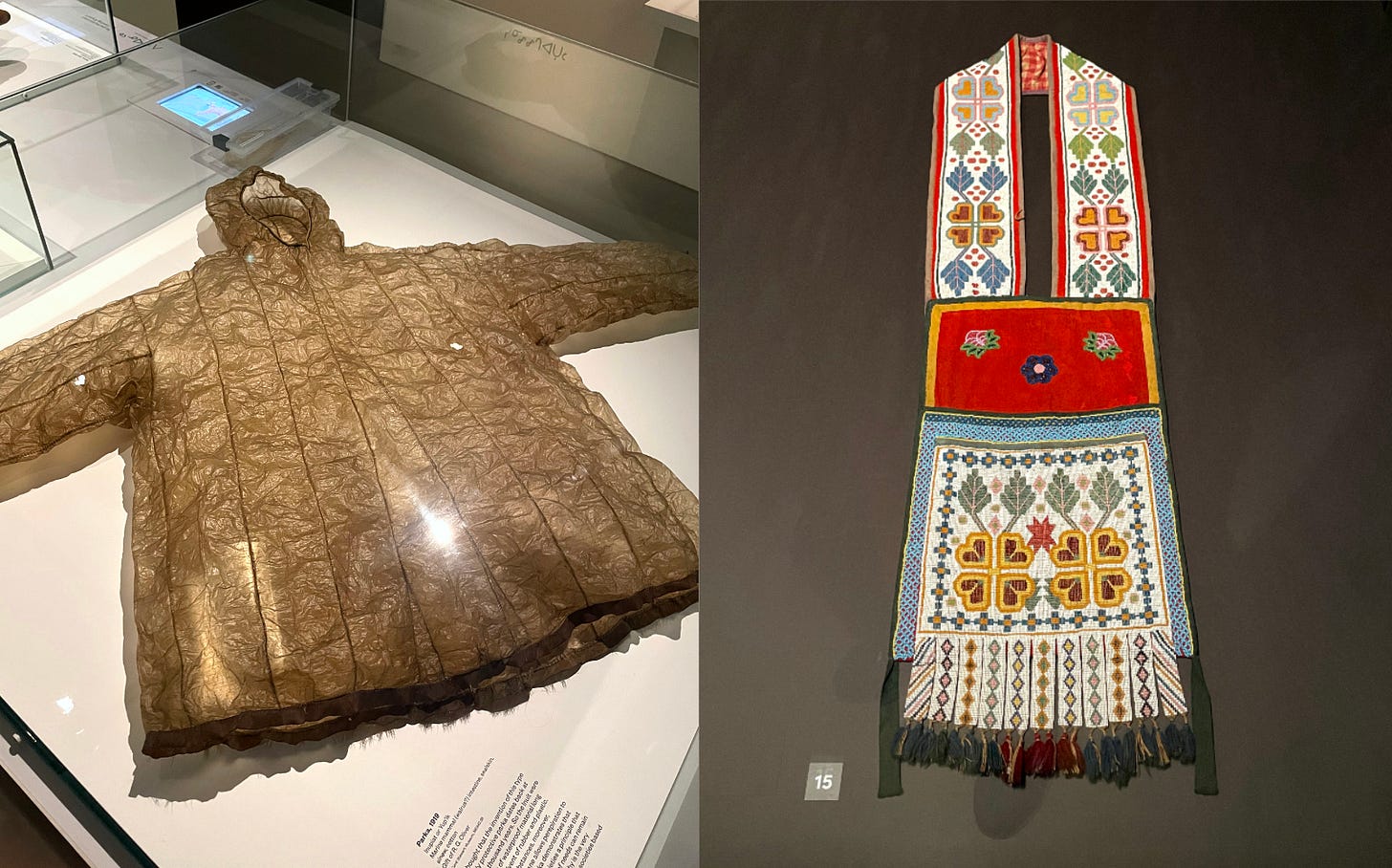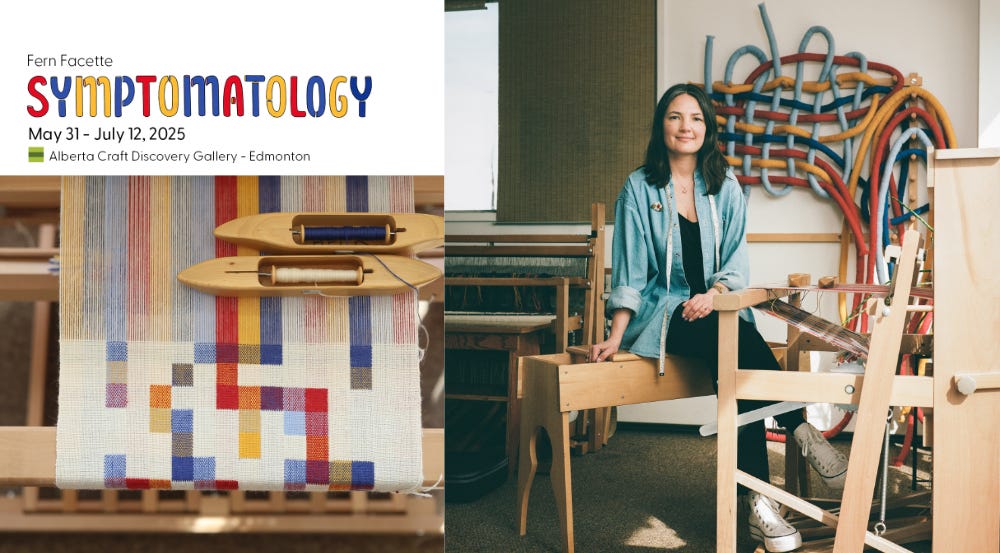In this newsletter you’ll find:
Studio Views
Things to See & Read
Studio Views
Since my last newsletter I have been doing a lot of teaching and a bit of travelling!
I taught my Stripe Lab workshop twice (learning a lot in the process, as you do…). These are images from the session at Irene Textile. What a space!!! If you find yourself in Montreal, please make sure to visit Yde’s shop — she carries some really unique yarns and materials and is a beautiful working space. I met so many nice people — next time I visit I hope we can meet again :)
While in Montreal we went thrifting and I did not get this hand spun and hand woven coverlet (or the several catalogne I saw) but I gave it the admiration it is due (I am always curious about object histories!). I did, however, get this porcupine quill basket.
We went to see Pounding the Pavement: Montreal Street Photography at the McCord Stewart Museum, and I really enjoyed the craft work on display in Indigenous Voices Today. On the left is a waterproof parka made from animal intestine; it was accompanied by a video with several women talking about the labourious process of preparing the intestines. On the right is a bandolier bag also in the exhibition.
Now I am getting ready for an artist residency in Denmark (naturally this means I am panic weaving/sewing things I am convinced I will need)! I’m going to Det Vilde Spinderi to do a bit of skilling-up and creative exploration. I’m really looking forward to seeing The Power of Print at the Danish Design Museum, featuring the weave-like textile prints of Lisbet Friis, and visiting the Louisiana Museum of Modern Art, which every single person has told me is a must-visit. If you’re in Copenhagen, Sjælland or Malmö, Sweden, reach out and maybe we can connect.
Things to See & Read
If you are in Edmonton, Alberta this June, please go and visit Fern Facette’s exhibition at the Alberta Craft Discovery Gallery! I dearly wish I could see these doubleweave pieces and woven tubes (!) that explore Fern’s experience of an ADHD diagnosis. Exploring neurodiversity through the metaphor of weaving and interlacement, this is Fern’s first solo exhibition and it sounds and looks really beautiful. Congrats Fern!! If you’re visiting or in Edmonton, check out the great workshops she hosts at Fern’s School of Craft, too.
Claudy Jongstra speaks about working with wool and her monumental felt pieces in a recent episode of the Material Matters podcast, underlining her unusually deep commitment to sustainability — she has her own flock and grows all her own natural dyes! As a follow up, I read this article, Claudy Jongstra “Natural Dyes are the gold of the future”, which expands a bit more on her biodynamic farm in Friesland and the many steps her work takes from seed to sheep to art.
I recently watched this short (7min) film on Sardinian weaving and spinning. My favourite part was when friends of 86 year old Gonaria complain that she never used to visit anyone because she was married to her loom — she is quick to note it still is her passion! I also found it fascinating to see how weaving traditions are shared. Sometimes the textiles reminded me of Moroccan rugs (which makes sense because of Sardinia’s proximity to Al-Andalus and North Africa — no doubt cultural and material trade was rampant!1), and at other times Diné eyedazzlers or Scandinavian/Nordic rugs. It’s a nice reminder of how our textile traditions and visual languages are shared, borrowed, adapted, and enriched through migration and trade.
Another film! This time a documentary about Justine Aldersey-Williams, the woman who grew flax, spun it into yarn, wove her own linen yardage, and finally sewed her own jeans. Woman Grows Jeans premieres on June 11, 2025 and I am really looking forward to watching it — I’ve linked the trailer below.
The National Gallery of Victoria in Australia has a new exhibition open called Kimono, which explores the extraordinary impact this garment has had in Japan and worldwide. Displaying both historical and contemporary pieces, I was happy to get a peek through this feature in The Guardian. I’ve seen two exhibitions of kimonos that left lasting impressions: one in Kyoto when I was a student at Kawashima Textile School, and the other was Artistry in Silk: The Kimono of Itchiku Kubota in 2018 at the Textile Museum of Canada.
Also in the Guardian a few weeks ago was a fascinating visual essay about natural dyeing by Mexico’s indigenous Mixtec people, who “milk” rare Plicopurpura colummelaris snails to get them to excrete a milky substance, which reacts with UV light to turn yarn an indelible purple (the snails go back onto the rocks once the short process is complete). It’s a fascinating story of indigenous knowledge, textile production, and, of course, climate change, the latest threat facing this traditional practice. It’s well worth visiting the article to see the extraordinary shade of violet and witness the landscape this colour comes from and the craft objects these snails contribute to.
This newsletter is taking a summer holiday while I am away in Denmark — see you in late August or September!
Amanda
I did get curious about this, and enjoyed learning that Sardinia was once part of Phoenicia! There is more about the Phoenician and Punic peoples’ archeological and architectural influence here, should you be equally as curious. I also thought this abstract sounded interesting…









It's so wonderful to read about all the happenings within the world of fibre.
Weaving can be isolating (a good thing for me as an introvert) but the community and knowledge that comes with the craft of fibre has been the inspiration behind what keeps me going. The things you can do and learn are endless and it's so so wonderful.
Have an amazing time in Denmark!